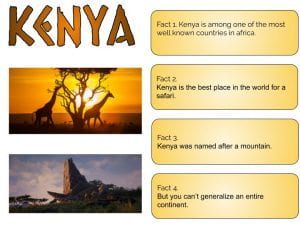
4 Facts – Kenya
- Author By pespaeget
- Publication date March 21, 2022
- Categories: Hanga | Create
- No Comments on 4 Facts – Kenya
China is one of the oldest civilizations in the world, and in the years since its creation there have been many wondrous and amazing buildings, monuments, and military sites that have been built. Let’s take a look at some of the most famous ones.
The magnificent Great Wall of China – known in Chinese as ‘Changcheng’, or the ‘Long Wall’ – stretches more than 6,000 kilometres from the fortresses of Shanhaiguan in the east all the way to Jiayuguan in the west, passing through Hebei, Tientsin, Beijing – where the best preserved sections of the wall can be visited – Inner Mongolia, Ningxia, and Gansu.
Averaging six to eight metres in height but rising as high as 16 metres – and wide enough in places for five horses or 10 men to pass – the wall boasts numerous battlements and watchtowers. Some of the wall’s oldest fortifications date back as far as the 7th century BC, with the best-known areas added around 210 BC when its various sections were joined together.
Today, the most visited section of the wall is near Badaling Pass northwest of Beijing, easily reached by public transport or organised tours. Other restored sections worth a visit include the section near Gubeikou, 130 kilometres from Beijing; and in Mutianyu, just 70 kilometres northeast of Beijing.
China’s largest and most important building, the Forbidden City (Zǐjìnchéng) – also known as the Imperial Palace – is in the very heart of Beijing and is a must-see when visiting the country. Started during the Yuan Dynasty between 1271-1368, much of the city seen today was built between 1406 and 1420. It’s really many palaces combined into one location, and was home to 24 different Chinese emperors. It is called the Forbidden City because nobody except the royal family, and their staff.
The Terracotta Army. It was while digging wells near Xi’an in the 1970s that farmers stumbled across what was to be China’s most important archeological find: the Terracotta Army. Spread out over three large underground pits and built to guard the First Emperor’s tomb, the find included more than 8,000 life-size warriors, some 520 horses, and more than 100 chariots, along with numerous other non-military characters dating from around 280 BC. They are called terracotta because that is the name of the material used to create the statues.
Zhangjiajie National Forest Park, Hunan. When you first set eyes on Zhangjiajie National Forest Park in Hunan province, it’s easy to see why James Cameron used this as inspiration for his movie “Avatar” . Its many unique pillar-like rock formations look like some incredible alien landscape right out of a sci-fi movie. One of the tallest pillars, standing at an impressive 1,080-meters, has been renamed “Avatar Hallelujah Mountain.” These amazing creations were not built, but were formed millions of years ago.
Chimelong Ocean Kingdom was built in 2010 and is made up of seven themed areas. These areas have more that 54 million litres of water across its various attractions earning it the Guinness World Record for Largest Aquarium, but that’s not all. The park’s main, and best attraction, the Whale Shark tank also managed to win four more world records all by itself. The massive tank that holds the world’s largest species of shark, holds over half of the entire park’s water at almost six million gallons making it the largest aquarium tank in the world. Visitors can also view the sea life in the tank through a large window that holds the record for both largest aquarium window and largest acrylic panel in the world.